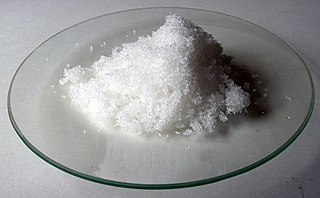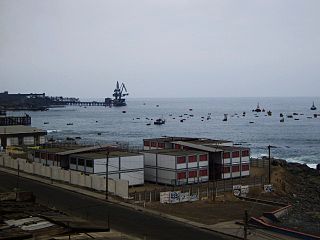
A ghost town is an abandoned village, town, or city, usually one that contains substantial visible remaining buildings and infrastructure such as roads. A town often becomes a ghost town because the economic activity that supported it has failed or ended for any reason. The town may also have declined because of natural or human-caused disasters such as floods, prolonged droughts, extreme heat or extreme cold, government actions, uncontrolled lawlessness, war, pollution, or nuclear disasters. The term can sometimes refer to cities, towns, and neighbourhoods that, though still populated, are significantly less so than in past years; for example, those affected by high levels of unemployment and dereliction.

The Antofagasta Region is one of Chile's sixteen first-order administrative divisions. The second-largest region of Chile in area, it comprises three provinces, Antofagasta, El Loa and Tocopilla. It is bordered to the north by Tarapacá, by Atacama to the south, and to the east by Bolivia and Argentina. The region's capital is the port city of Antofagasta; another one of its important cities is Calama. The region's main economic activity is copper mining in its giant inland porphyry copper systems.

Sodium nitrate is the chemical compound with the formula NaNO
3. This alkali metal nitrate salt is also known as Chile saltpeter to distinguish it from ordinary saltpeter, potassium nitrate. The mineral form is also known as nitratine, nitratite or soda niter.

The Atacama Desert border dispute was a dispute between Chile and Bolivia from 1825 to 1879 for the territories of the Atacama Coast due to the different views of both countries of the territory inherited from the Spanish Empire. During the dispute, both countries signed Treaties in 1866 and 1874. The dispute occurred prior to the War of the Pacific, which settled the dispute in favor of Chile. Due to the surrender of land by Bolivia, the Puna de Atacama dispute was generated between Chile and Argentina and was settled in 1899.

Chuquicamata is the largest open pit copper mine in terms of excavated volume in the world. It is located in the north of Chile, just outside Calama, at 2,850 m (9,350 ft) above sea level. It is 215 km (134 mi) northeast of Antofagasta and 1,240 km (770 mi) north of the capital, Santiago. Flotation and smelting facilities were installed in 1952, and expansion of the refining facilities in 1968 made 500,000 tons annual copper production possible in the late 1970s. Previously part of Anaconda Copper, the mine is now owned and operated by Codelco, a Chilean state enterprise, since the Chilean nationalization of copper in the late 1960s and early 1970s. Its depth of 850 metres (2,790 ft) makes it the second deepest open-pit mine in the world, after Bingham Canyon Mine in Utah, United States.

Tocopilla is a city and commune in the Antofagasta Region, in the north of Chile. It is the capital of the province that bears the same name.

Humberstone and Santa Laura Saltpeter Works are two former saltpeter refineries located in northern Chile. They were declared a UNESCO World Heritage Site in 2005, as a testament to the historical importance of saltpeter mining in Chile and the culture and social agenda that developed around it in the late 19th century. The works were placed on the World Heritage List in Danger that same year, due to the fragility of the derelict buildings, but was removed in 2019.

Pisagua is a Chilean port on the Pacific Ocean, located in Huara comuna (municipality), in Tarapacá Region, northern Chile. In 2007, the new province of El Tamarugal was established and the comuna of Huara, previously within the province of Iquique, was incorporated to the newly created province.

Sociedad Química y Minera de Chile (SQM) is a Chilean chemical company and a supplier of plant nutrients, iodine, lithium and industrial chemicals. It is the world’s biggest lithium producer.

Pampa del Tamarugal is a vast plain encompassing a significant portion of the Norte Grande, Chile, and originally named for the Prosopis tamarugo trees that used to cover its surface. It is located between the parallels 19°30’ and 22°15’ south latitude and is considered part of the Atacama Desert. It is bounded on the west by the Chilean Coastal Range and on the east by the western slopes of the Andes. The plain occupies a surface area of 12,500 km2 with an average elevation of 1,100 m.

The Santa María School massacre was a massacre of striking workers, mostly saltpeter works (nitrate) miners, along with wives and children, committed by the Chilean Army in Iquique, Chile on December 21, 1907. The number of victims is undetermined but is estimated to be over 2,000. It occurred during the peak of the nitrate mining era, which coincided with the Parliamentary Period in Chilean political history (1891–1925). With the massacre and an ensuing reign of terror, not only was the strike broken, but the workers' movement was thrown into limbo for over a decade. For decades afterward there was official suppression of knowledge of the incident, but in 2007 the government conducted a highly publicized commemoration of its centenary, including an official national day of mourning and the reinterment of the victims' remains.

The Atacama Desert is a desert plateau in South America covering a 1,600 km (990 mi) strip of land on the Pacific coast, west of the Andes Mountains. The Atacama Desert is the driest nonpolar desert in the world, and the second driest overall, just behind some very specific spots within the McMurdo Dry Valleys as well as the only hot true desert to receive less precipitation than the polar deserts, and the largest fog desert in the world. Both regions have been used as experimentation sites on Earth for Mars expedition simulations. The Atacama Desert occupies 105,000 km2 (41,000 sq mi), or 128,000 km2 (49,000 sq mi) if the barren lower slopes of the Andes are included. Most of the desert is composed of stony terrain, salt lakes (salares), sand, and felsic lava that flows towards the Andes.
The mining sector in Chile is one of the pillars of Chilean economy and copper exports alone stands for more than one third of government income. Most mining in Chile is concentrated to the Norte Grande region spanning most of the Atacama Desert. Mining products of Chile includes copper, gold, silver, molybdenum, iron and coal. Chile was, in 2019, the world's largest producer of copper, iodine and rhenium, the second largest producer of lithium and molybdenum, the sixth largest producer of silver, the seventh largest producer of salt, the eighth largest producer of potash, the thirteenth producer of sulfur and the thirteenth producer of iron ore in the world. In the production of gold, between 2006 and 2017, the country produced annual quantities ranging from 35.9 tons in 2017 to 51.3 tons in 2013.

Nostalgia for the Light is a 2010 documentary film by Patricio Guzmán to address the lasting impacts of Augusto Pinochet's dictatorship. Guzmán focuses on the similarities between astronomers researching humanity's past, in an astronomical sense, and the struggle of many Chilean women who still search, after decades, for the remains of their relatives executed during the dictatorship. Patricio Guzmán narrates the documentary himself and the documentary includes interviews and commentary from those affected and from astronomers and archeologists.
The Battle of Chacabuco was a decisive victory fought by Chilean and Argentine forces against the Spanish forces in Chile during the Chilean War of Independence in 1817. The name Chacabuco may also refer to:

Pulperia was the name given to company stores and dining facilities in parts of South America, notably in the industries that extracted sodium nitrate from caliche deposits between 1850 and 1930 in Northern Chile in the current regions of Tarapaca and Antofagasta. The term was used in the Spanish colonial period in South America.
Humberstone is a ghost town in the Atacama of Chile. Developed for the extraction of saltpeter, it is a Chilean National Monument and part of a UNESCO World Heritage Site designated as Humberstone and Santa Laura Saltpeter Works.

The Battle of Tambillo was a battle of the War of the Pacific that occurred on December 6, 1879, between the Bolivian 5th Division under the command of Colonel Rufino Carrasco and the Chilean garrison stationed at the town commanded by Lieutenant Emilio Ferreira.















